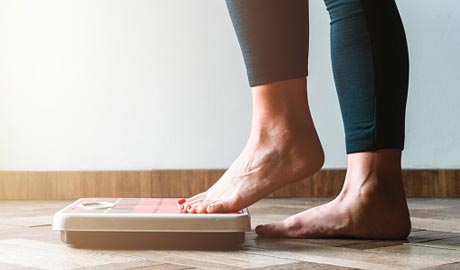Background: The health consequences of obesity are numerous, including, for example, cardiovascular disease and diabetes. For many years, researchers have speculated that menopause transition is a contributing factor to obesity; some studies have found gains in body fat and weight in midlife. But they could not sort out whether these gains were menopause-related or aging related.
Objective: The goal of this study was to determine whether the menopause transition influences body composition or body weight.
Methods: The investigators used longitudinal data from SWAN to quantify change in body composition and body weight during an 18-year time interval, from approximately 9 years prior to through 10 years after the final menstrual period. They describe the timing and amount of increases in fat mass and weight and decreases in lean mass. In addition, they evaluated whether racial/ethnic origin influences the patterns of change in body composition and weight.
Results: About 2 years prior to the final menstrual period (which defines the start of the menopause transition in this study), the rate of fat gain doubled and lean mass started to decline. Fat gains and lean losses continued until 2 years after the final menses (which defines the end of the menopause transition in this study). In postmenopause, the trajectories of fat and lean mass became “flat” – there were no gains or losses. Body weight increased linearly (without an abrupt change at the onset of the menopause transition) from pre-to post menopause and the rate of change in weight also flattened out 2 years after the final menstrual period. There is no detectable change in rate of weight gain in during the menopause transition because the accelerated gain in fat mass and the simultaneous loss of lean mass “balance each other out”. Black and White women had similar patterns of change in body composition and weight. Japanese women lost some lean mass during the menopause transition but did not gain fat mass. Chinese women gained lean mass and lost fat mass during postmenopause.
Conclusion: Menopause is accompanied by gains in fat mass and losses of lean mass that subside in postmenopause, strongly suggesting that the menopause transition is affecting women’s metabolism. The study also demonstrates that simply measuring body weight does not illustrate what’s happening “under the skin” – gains in fat and losses of lean are not captured by total weight on the scale. Other researchers have reported that the ability of body mass index to foretell the risk of conditions such as diabetes or cardiovascular disease declines in older women. The menopause-related shifts in fat and lean mass that we uncovered in SWAN may be one reason for the decline in the predictive capacity of body mass index in older women.
Authors: Gail A. Greendale – UCLA, Barbara Sternfeld – Kaiser Permanente, MeiHua Huang – UCLA, Weijuan Han – UCLA, Carrie Karvonen-Gutierrez – University of Michigan Ann Arbor, Kristine Ruppert – University of Pittsburgh, Jane A. Cauley – University of Pittsburgh, Joel S. Finkelstein – Massachusetts General Hospital, Boston, Sheng-Fang Jiang – Kaiser Permanente, and Arun S. Karlamangla – UCLA.
Funding: NIH, Department of Health and Human Services (DHHS), through the National Institute on Aging, National Institute of Nursing Research, and NIH Office of Research on Women’s Health (U01NR004061, U01AG012505, U01AG012535, U01AG012531, U01AG012539, U01AG012546, U01AG012553, U01AG012554, and U01AG012495).
This article: Changes in Body Composition and Weight During the Menopause Transition was published in Volume 4, Issue 5 of Journal of Clinical Investigation Insight on March 7 2019 – JCI Insight. 2918;4(5):e124865
View the article here:







